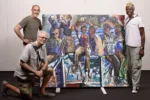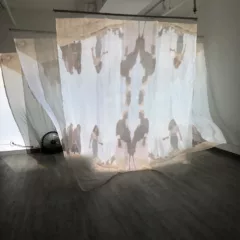To create a hybrid means to capture and combine two seemingly different things to fashion one new cohesive thing. For example, look at a grapple. This hybrid fruit was genetically modified to combine the tastes of sour grapes and sweet apples- totally different flavors but somehow, they go well together. At Twelve Gates Arts, Australian artist Damon Kowarsky and Pakistani artist Atif Khan combine their two distinctive backgrounds and flavors to create the artistic version of a grapple. This harmonious display of collaborative work is aptly entitled, “Hybrid.” For 11 months, the two men exchanged a total of twenty sketches that were drawn by one artist and then altered by the other. The two artists were friends and though they lived on separate continents, they exchanged their drawings via snail mail. In November of 2011, the artists finally got together at the National College of Arts in Lahore, Pakistan to create the final prints. The resulting work seamlessly combines the ethnic, stamp-like designs of Khan and the crisp illustrations of Kowarsky — two things, like a grape and an apple, that somehow go together.
The show comments on ideas such as power, politics, war and cultural symbols and the artists often reference South Asian and geographically relevant motifs.
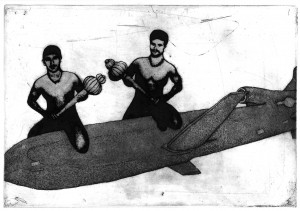
The theme of flight as represented by both wind and aircrafts is notable throughout the show. “Pehalwan” depicts two wrestlers straddling a drone. The word “pehalwan” means wrestler in English and refers to a this model of theatrical strength and self-importance. When the curator and I spoke, she talked a lot about the drones as symbols of war. They reference Pakistan’s ongoing frustration with the United States’ drone strikes. Though these drones are unmanned “machines of war,” they are still directed and guided by these political powerhouses in the US. The piece references the swagger of the wrestlers and how often times, the bravado and pride of these men can lead to fatalities.
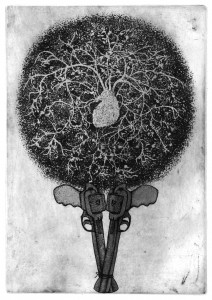
In an even more overt reference to contemporary warfare, “Bouquet” depicts two guns as stems that support a bushel of flowers. The bushel is round like the world and within it, the buds and blooms are the various veins and arteries of a heart. The detail in this print is incredible and resembles a sort of creepy Victorian illustration where something supposedly sweet such as a bouquet of flowers is actually meant to be quite dark and ominous. The message here suggests that the heartbeat of the world is sustained by guns and it speaks to the chaotic relationships between Pakistan and her neighbors at this time.
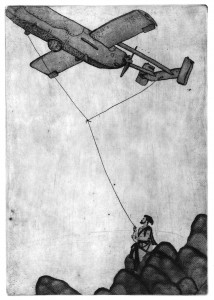
Continuing the themes of wind, war and drones, the print entitled “Kite” depicts a man guiding a drone by a kite string. Upon further discussion with curator Aisha Khan, I learned that this man is a king, as evidenced by his style of dress. This speaks again to the idea of one person’s political power and responsibility. Though the image seems ridiculous, it recalls the whimsy with which powerful men sometimes appear to make their decisions. From our perspective, their direction and mood can seem as fickle as the wind and the fact that the king can direct the drone by a string indicates his extraordinary power
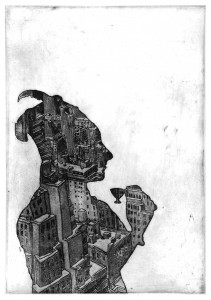
The print above entitled “Nur Jahan” is the silhouette of the famous Empress of the Mughal Empire. Inside the form is a scene from a New York city rooftop as depicted by Kowarsky. Previously unfamiliar with her story, I was attracted to the piece due to its detailed simplicity. The image is clean yet striking. Upon talking with Aisha Khan, I learned that this queen is particularly well-known in history due to the exceptional imperial power she wielded as the wife of an emperor. To meld an image of New York, the Western paragon of a very liberal and overwhelming power, with the iconic shape of Nur Jahan creates a very globalized and universal understanding of indestructible strength.
Our typical idea of an artist does not fall far from that of a politician in that both are incredibly influential and expected to be uncompromising in their devotion to their vision. “Hybrid” calls into question the sort of power that an artist must relinquish in order to successfully collaborate with another artist. Oftentimes we can see when an artist has compromised his vision, but in this case, that is not so. Each piece holds distinct marks of both Kowarsky and Khan and yet, the work is so unified. The entire show reads as two harmonious voices speaking the same message. The message tastes both sweet and sour and like the grapple, it is quite delicious.
“Hybrid” is on display at Twelve Gates Arts until March 30, 2013. All images are courtesy of Aisha Khan @ Twelve Gates Arts



